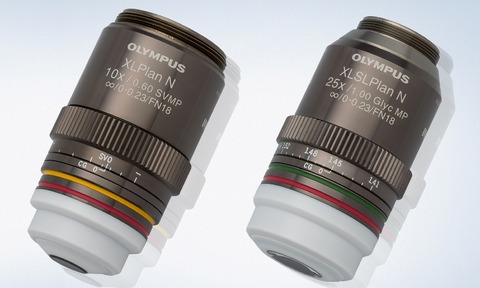
Olympus has launched dedicated multiphoton excitation (MPE) objectives for deep imaging.
Dedicated to multiphoton excitation microscopy, the XLPLN10XSVMP and XLSLPLN25XGMP objective lenses feature an 8 mm working distance and support for a large range of refractive indices (RI).
The objectives enable super-deep imaging of tissues treated with the latest clearing agents as well as live-cell imaging and light sheet microscopy techniques.
Compatible with the industry leading FVMPE-RS and FV1200MPE multiphoton microscopy systems and adaptable to home-build light sheet microscopes, the objectives have a range of features designed to benefit researchers.
Both objectives feature working distances of 8 mm, providing the capability and space for structural and live-cell imaging deep within large intact samples (such as whole mouse brain), especially useful in neuroscience applications.
A transmittance range of 400-1600 nm extending into the infra-red spectrum allows deeper imaging with minimal damage to the tissue, and is well-suited to combine conventional multicolour MPE imaging with label-free methods such as third- and second-harmonic generation.
A field number of 27.5 provides excellent scattered light collecting abilities while a correction collar allows compensation of refractive index mismatches.
In addition, spherical aberrations are corrected across the visible to infra-red (IR) range, with additional chromatic aberration correction in the IR range.
The XPLN10XSVMP features multi-immersion capability, which enables its use with water, silicone and oil as well as clearing agents such as SCALEVIEW(1), Clarity(2) and SeeDB (RI 1.33-1.52)(3).
Deep macro observation is achieved with high resolution at a large field of view (FOV – 1.8 mm at 10X magnification).
The XLSLPLN25XGMP also supports the latest in clearing agents such as Clarity and SeeDB for cutting-edge research techniques, aided by a high RI immersion capability of 1.41-1.52 (SeeDB requires an RI of 1.49).
The additions to Olympus’ XLPLN series of objectives enable the interrogation of large intact samples (such as whole-brain high-resolution imaging) and structural and molecular analysis of large assembled biological systems.
The large FOV provided by the objectives enhances data collection from samples treated with the latest clearing agents by several orders of magnitude and this combined with unsurpassed flexibility and correctional capabilities makes them the clear choice for researchers using MPE or light sheet microscopy techniques.





